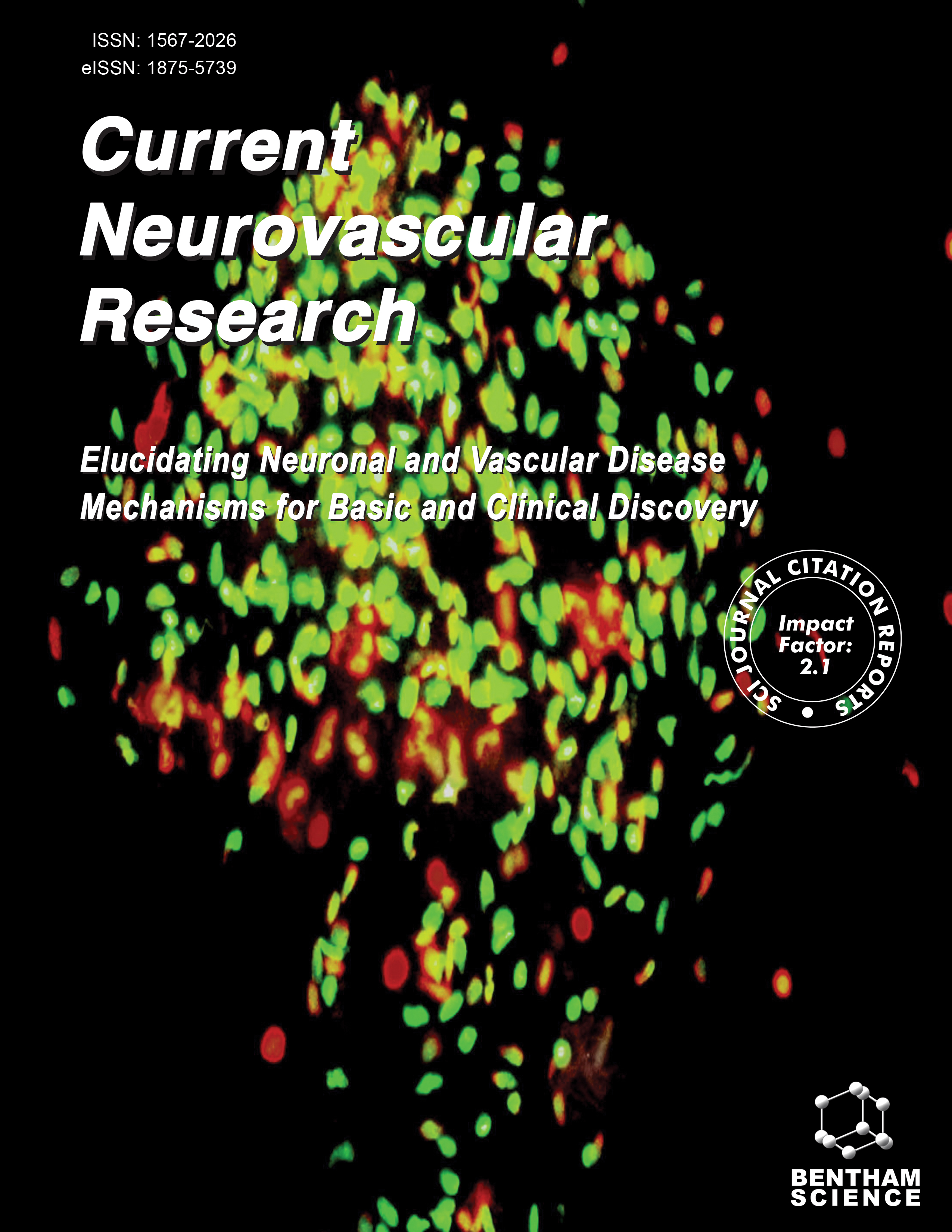- Home
- A-Z Publications
- Current Neurovascular Research
- Previous Issues
- Volume 19, Issue 5, 2022
Current Neurovascular Research - Volume 19, Issue 5, 2022
Volume 19, Issue 5, 2022
-
-
The Impact of the Initial Admission Department on the Management and Prognosis of Retinal Artery Occlusion
More LessAuthors: Yanqin Liu, Shuju Dong, Yaxi Luo, Yanbo Li, Changling Li, Dong Zhou and Li HeBackground: Retinal artery occlusion (RAO) is an emergency condition in both neurology and ophthalmology departments. However, RAO's management and visual outcome in different initial departments remain unclear. Therefore, we aimed to investigate the impact of the initial department on the management and prognosis of RAO. Methods: Consecutive cases of RAO between January 2011 and December 2021 Read More
-
-
-
Tandem Mass Tag (TMT) Quantitative Proteomic Analysis of Serum Exosomes in Cerebral Small-vessel Disease (CSVD) Patients With Depressive Symptoms
More LessAuthors: Yanjing Lu, Rong Shen, Hao Zhu, Qian Feng, Yifan Li, Wenxin Xu, Dayong Zhang, Zhong Zhao and Hua ZhouBackground: Depressive symptoms are one of the main clinical features of the cerebral small-vessel disease (CSVD). However, the pathogenesis of depressive symptoms of CSVD has not been fully studied, and a lack of effective diagnostic methodseffective diagnostic methods exists. Recently, the emerging body of evidence regarding exosomes has rendered them potentially key players in the neuropsychiatric disease theragno Read More
-
-
-
Diindolylmethane Ameliorates Ischemic Stroke-Induced Brain Injury by Peripheral and Central Mechanisms
More LessAuthors: Kakarla Ramakrishna, Sushil Kumar Singh and Sairam KrishnamurthyIntroduction: Diindolylmethane (DIM), a major acid condensation product of Indole-3- carbinol, is known to inhibit platelet aggregation and thrombosis. The drugs with antiplatelet and antithrombotic activities are used to treat ischemic stroke. Objective: The present study investigated the role of DIM on platelet aggregation inhibitory properties in middle cerebral artery occluded (MCAO) rats. Methods: DIM (12.5, 25, an Read More
-
-
-
Multimodality Treatment of Deep-seated Cerebral Arteriovenous Malformations: The Experiences of One Center
More LessAuthors: ZhenLong Ji, SiShi Xiang, JingWei Li, Jin Xu, JiaXing Yu, JiaWei Qi, GuiLin Li and HongQi ZhangObjective: Treatment of deep-seated cerebral arteriovenous malformations (AVMs) remains challenging for neurosurgeons or neuroradiologists. This study aims to review the experiences of one center in using multimodality treatment for deep-seated AVMs. Methods: The AVM database of Xuanwu Hospital, Capital Medical University was searched, and 96 patients who were diagnosed with a deep-seated cerebral AVM betwe Read More
-
-
-
Lesion Location Predicts Early Neurological Deterioration in Single Subcortical Infarction
More LessAuthors: Ke Zhang, Hongbing Liu, Ce Zong, Hongxun Yang, Anran Wang, Yunchao Wang, Lulu Pei, Kai Liu, Yapeng Li, Hui Fang, Lu Zhao, Yan Ji, Yusheng Li, Bo Song, Yuming Xu and Yuan GaoBackground: A certain number of patients with single subcortical small infarction (SSSI) in the lenticulostriate artery (LSA) territory present with early neurological deterioration (END). Objective: We sought to identify a more specific predicting imaging marker for END in lenticulostriate SSSI patients. Methods: We screened patients in a prospective hospital-based registry of stroke in the first Affiliated Hospital of Zhengzhou Un Read More
-
-
-
Inverted U-shaped Relationship Between Mean Platelet Volume/Platelet Count Ratio and Post-thrombolytic Early Neurological Deterioration in Patients with Mild and Moderate Stroke
More LessAuthors: Wei Xu, Hongquan Guo, Huiping Li, Kangping Song, Fangyi Li, Zhen Wang and Xinfeng LiuObjective: The objective of this study is to investigate the relationship between mean platelet volume (MPV)/platelet count (PC) ratio and post-thrombolytic early neurological deterioration (END) in patients with mild and moderate stroke. Methods: Mild and moderate stroke patients treated with intravenous thrombolysis (IVT) at the Affiliated Changsha Central Hospital of the University of South China between January 2016 an Read More
-
-
-
Early Cognitive Impairment at Acute Stage After Intracerebral Hemorrhage
More LessAuthors: Yaqian huang, Cong Gu, Wei Zhang, Jiayun Wang, Jiaping Xu, Jing Liu, Hua Hu, Shoujiang You and Yongjun CaoBackground: Cognitive impairment after acute intracerebral hemorrhage (ICH) is common. While the evidence of early cognitive impairment at the acute stage after ICH is limited. We determined the frequency and risk factors of early cognitive impairment at the acute stage and investigated its association with delayed cognitive impairment after ICH. Methods: A total of 208 patients with acute ICH were enrolled from January 201 Read More
-
Volumes & issues
-
Volume 21 (2024)
-
Volume 20 (2023)
-
Volume 19 (2022)
-
Volume 18 (2021)
-
Volume 17 (2020)
-
Volume 16 (2019)
-
Volume 15 (2018)
-
Volume 14 (2017)
-
Volume 13 (2016)
-
Volume 12 (2015)
-
Volume 11 (2014)
-
Volume 10 (2013)
-
Volume 9 (2012)
-
Volume 8 (2011)
-
Volume 7 (2010)
-
Volume 6 (2009)
-
Volume 5 (2008)
-
Volume 4 (2007)
-
Volume 3 (2006)
-
Volume 2 (2005)
-
Volume 1 (2004)
Most Read This Month
Article
content/journals/cnr
Journal
10
5
false
en


